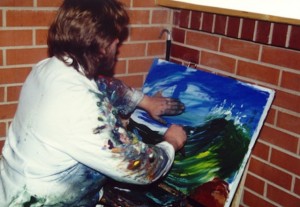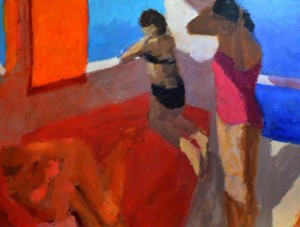Also, it’s important to note that there are a few people on the list who are considered legally blind, which means they do have some vision, but not much. In order to be considered legally blind, someone needs to have 20/200 vision in their best eye. For some perspective, that is just being able to read the big letter “E” on an optometrist’s chart. So while a few of them do have some vision, painting is an incredibly complex process involving shading, color, depth perception, lighting, and many more aspects that wholly rely on the eyes, so overcoming their impairment is still an outstanding feat.
10. Michael Williams
Born in Memphis, Tennessee in 1964, Michael Williams first became interested in art while watching his mother, who was an artist, draw a cowboy riding off into the sunset. Williams then trained himself how to draw and moved on to painting. But as a teenager, he was diagnosed with Stargardt’s disease, which is a degenerative disease that affects people before the age of 20 and effects their eyesight. Despite losing much of his vision, Williams continued to draw and won a number of awards in high school.
In order to paint, Williams uses a powerful magnifying glass and leans in closely to the canvas. Since his vision is so limited, he has a problem deciphering between certain shades and colors so a lot of the time he has to improvise with his work. Williams will spend anywhere from two weeks to a year adding detail in the painting, but he, like the rest of the painters on the list, will never be able to see the picture as a whole or much of the intricate details that have gone into the painting.
When Williams is asked about his impairment, he says that, “just because you’re limited in sight, you don’t have to be limited in insight.”
9. Hal Lasko
Painting can be done in many ways and not many people would consider someone who uses Microsoft Paint a painter. But what do you call someone like Hal Lasko, who made beautiful works of art using the program? What makes Lasko’s work even more impressive is that when he created amazing pictures on Paint, he was in his late 80s and 90s and was also legally blind.
Lasko was born in 1915 and served in World War II, where he had a job planning bombing raids. After the war, he lived in Cleveland and worked as a graphic designer before going into topography. He developed his own notable font and worked as a designer for American Greetings before retiring in the 1970s. In 2000, Lasko’s grandson showed him Microsoft Paint on a computer that the family bought him for his 85th birthday. Lasko played around with the basic art program that comes with Microsoft Windows and seemed to really enjoy it.
Paint became very important to Lasko in 2005, when he lost some of his vision due to wet macular degeneration, which causes the central vision to deteriorate. So the only way he can see things clearly is to look at them sideways. He said that Paint allowed him to magnify things enough so that he could see them and then painted his masterpieces pixel by pixel. He also said that he could work with his eyes closed.
Lasko’s work is described as a cross between Pointillism and 8-Bit. He was featured in a Super Bowl ad in 2014 and the day after the Super Bowl, he had his first solo exhibit in Cleveland. On July 6, 2014, Lasko passed away at the age of 98.
8. Keith Salmon
Born in Essex, United Kingdom, in 1959, Keith Salmon studied fine art and graduated in 1983. After graduating, he worked as a sculptor and painter for several years, but in 1989, he was diagnosed with diabetic retinopathy and his eyesight deteriorated quickly, eventually leaving him legally blind. A setback like blindness may have been devastating to many other artists, but Salmon became more determined and dedicated to his artwork.
What’s impressive about Salmon is that he paints landscapes, which he, of course, can’t see, nor can he get a sense of the landscape using his hands, like someone could with small objects. Salmon, who was an active climber and hiker before going blind, continues on doing hikes along the hills in the United Kingdom, then paints the little that he does see and then combines it with what he feels and what he senses about the landscape.
7. Arthur Ellis

In the late 1960s, Arthur Ellis was an art student and graduated with a degree in Fine Art. He moved to London, England and tried to make a career for himself before moving back to his hometown of Tunbridge Wells. There, he worked full time as a print finisher and worked on drawings, paintings and sculpting in his spare time, thinking one day he would become a full time artist. But life, as it tends to do, got in the way and he worked at his day job for 26 years. In 2006, he went to the doctor’s with an earache. His doctor quickly figured out that Ellis had meningitis and he was immediately hospitalized, and fell into a coma.
Ellis’ family was told to expect the worst over the next nine months, including brain damage and life support. Ellis survived, but lost his sight and much of his hearing. After returning home, Ellis was determined to continue drawing. Through a series of trial and errors, he created a technique where he uses Blu-Tack to map out the picture. Then he has a tool that is similar to a bar code reader that he can press against the tube and it will tell him what color the paint is.
Ellis also suffers from Charles Bonnet Syndrome, which is a condition where blind people undergo vivid and recurring visual hallucinations. He then includes these hallucinations in his artwork.
6. Sergej Popolsin

Born in Russia in 1964, Sergej Popolsin grew up in Siberia and as a young adult, he attended art school. Due to a number of personal problems and two years of mandatory military service, he never completed his schooling. From there, Popolsin had a turbulent life and in 1990, he attempted suicide. He survived, but suffered a serious head injury that left him blind.
While still recovering, Popolsin started to teach himself how to draw and paint. In order to orientate himself in terms of space and shape, he sticks pins into the canvas and uses that as a visual marker. Popolsin says that the hardest thing about painting is keeping the image in his head from the first stroke to the last because he can’t draw any rough plans before he paints it.
5. Binod Behari Mukherjee
In 1904, in India, Benode Behari Mukherjee was born blind in one eye, and the other was myopic. Unable to attend traditional schools because of his visual impairment, Mukherjee threw himself into painting. In 1919, he went to art school and in 1925, he became a teacher at the art school and he stayed on until 1949.
Throughout the years, his already poor eyesight deteriorated further and in 1954, he underwent an unsuccessful surgery for cataract removal and was left completely blind. After losing what little sight he had, Mukherjee continued to paint, draw, and sculpt using what he referred to as his inner eye and his years of experience to guide him. Mukherjee passed away in 1980 and is considered a legend in Indian modern art and he is one of the visually impaired painters to ever live.
4. Jeff Hanson
Jeff Hanson was a healthy baby when he was born in 1993, but as he aged, his parents noticed that there was something wrong with his vision. He kept bumping into things and when his father took him out one evening to show him the stars through a telescope, his father discovered that Jeff’s vision was so impaired that he couldn’t even see the stars in the sky. It turns out that Jeff had neurofibromatosis and it created a tumor in his brain that was causing him to lose his sight and stunted his growth. The doctors worked to shrink the tumor and this involved going through chemotherapy, which is a miserable experience for grown adults, let alone a child. So in order to keep her son occupied during chemo, Jeff’s mother planned an activity where he painted postcards with watercolor paints. As Jeff did the painting, he immediately felt a connection to visual art, even though he slowly was losing his vision.
His parents thought that his paintings were good, but just normal kid stuff, and then his mother started using the postcards as thank you cards for people who had helped them during the chemo process. That is when people started asking for duplicates, which led to Jeff selling them at a stand on his driveway and then the business really took off. Currently, he has a six month backlog and some famous fans. Warren Buffet has one of his paintingsand Elton John has two.
As for how much his paintings are worth, for an original, you’re looking at about $4,000. But what really makes Jeff’s story so amazing is that for every painting that is purchased, he donates another painting to charity for things like auctions. At these auctions, his paintings will often go for as high as $20,000. This strategy was so successful that Jeff raised $1 million and donated it all to charity before he turned 20.
How Jeff, who is legally blind, paints is that he puts a plastic “goop” on the front and the sides of the canvas. This goop leaves ridges when it hardens and then he uses the ridges to feel along the canvas to coordinate himself.
3. Sargy Mann

In 1973, when English painter and art teacher Sargy Mann was 35, he had cataract removal surgery. This was the first of a number of operations on his eyes, and each time the surgeries left his eye sight in worse shape. While going blind is difficult, Mann did find something interesting in his vision’s deterioration. He found that each time he had a procedure, he said that the way he saw things had changed. So at each stage, he learned how to see the world again and then taught himself how to paint his new vision, which gave him a unique artistic insight.
In May of 2005, Mann traveled to Spain to do some painting for a few weeks. He returned to his home in Suffolk and the next day, which was his 68th birthday, Mann woke up and found that he was completely blind. Yet despite not being able to see, Mann continued to paint and it was during this time that he was most successful with his artwork. His paintings have been purchased by Steven Spielberg and Daniel Day Lewis and a large painting sells for about $75,000.
Mann managed to paint some of his best work by using pieces of Blu-Tack to coordinate the areas he wanted to paint and then he has his wife help out with color and tone. Mann said that when he painted he could see the canvas change color in his mind. Mann passed away on April 5, 2015.
2. Esref Armagan
Esref Armagan was born in 1953 in Turkey with one eye that was incredibly underdeveloped and the other eye was non-functional, meaning that he was blind from birth. Growing up in a poor family, Armagan didn’t receive any formal education and taught himself to read, write, and even draw despite his impairment. When he was just a child, he used cardboard and nails to draw shapes. By the time he was eight, he had completed his first picture, which was of a butterfly. When he was 18, Armagan was painting on full sized canvases.
The process in which Armagan paints is that he creates the image in his head, including the colors that he plans on using. Armagan uses five colors, plus white and black, and then mixes them. From there, he uses his fingers and amazing concentration to paint incredibly vivid and colorful scenes.
Armagan is remarkable because of his use of color, shadow, composition, perspective and scale. He is able to draw things as if they are fading into the distance and he can draw objects in three dimensions, which scientists thought was impossible for someone who has never had sight. In fact, drawing all three dimensions correctly for people who can see is quite challenging. Neuroscientists performed a brain scan on Armagan and they found out that when he draws, his visual cortex lights up, where with most blind people that area of the brain stays dark. This indicates that vision is much more than light coming into our eyes and that our brains are hardwired to understand things like space and depth.
1. John Bramblitt

John Bramblitt started losing his sight when he was a teenager, and in 2001, just as he was turning 30, he went completely blind. The doctors believe it was caused by epilepsy and Lyme disease that wasn’t diagnosed for three years. After going blind, Bramblitt was obviously depressed. Then, as he was learning mobility training, which involves walking with a cane, he thought if he could get across a street, he could get across a canvas. So Bramblitt, who wasn’t a formally trained painter before he went blind, taught himself a unique method in order to paint. What he creates are some truly breathtaking paintings that are alive with vivid color.
To create his paintings, he touches the objects and the models, or 3D models of their face, and then draws what he feels on a paper with a marker that leaves raised ink. On the canvas, which he makes himself, he re-draws his models and the objects with the raised ink and then maps out the colors for painting. He uses oil paints and can tell what color each paint is because of the way they feel, as the different colors have different textures. Then through a time consuming process, he adds layers and layers of paint with a brush in one hand and his other hand as a guide. Bramblitt’s work has become incredibly popular and there is a three week backlog just for prints of his work.

0 ความคิดเห็น:
แสดงความคิดเห็น